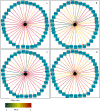Dynamic modularity of host protein interaction networks in Salmonella Typhi infection
- PMID: 25144185
- PMCID: PMC4140748
- DOI: 10.1371/journal.pone.0104911
Dynamic modularity of host protein interaction networks in Salmonella Typhi infection
Abstract
Background: Salmonella Typhi is a human-restricted pathogen, which causes typhoid fever and remains a global health problem in the developing countries. Although previously reported host expression datasets had identified putative biomarkers and therapeutic targets of typhoid fever, the underlying molecular mechanism of pathogenesis remains incompletely understood.
Methods: We used five gene expression datasets of human peripheral blood from patients suffering from S. Typhi or other bacteremic infections or non-infectious disease like leukemia. The expression datasets were merged into human protein interaction network (PIN) and the expression correlation between the hubs and their interacting proteins was measured by calculating Pearson Correlation Coefficient (PCC) values. The differences in the average PCC for each hub between the disease states and their respective controls were calculated for studied datasets. The individual hubs and their interactors with expression, PCC and average PCC values were treated as dynamic subnetworks. The hubs that showed unique trends of alterations specific to S. Typhi infection were identified.
Results: We identified S. Typhi infection-specific dynamic subnetworks of the host, which involve 81 hubs and 1343 interactions. The major enriched GO biological process terms in the identified subnetworks were regulation of apoptosis and biological adhesions, while the enriched pathways include cytokine signalling in the immune system and downstream TCR signalling. The dynamic nature of the hubs CCR1, IRS2 and PRKCA with their interactors was studied in detail. The difference in the dynamics of the subnetworks specific to S. Typhi infection suggests a potential molecular model of typhoid fever.
Conclusions: Hubs and their interactors of the S. Typhi infection-specific dynamic subnetworks carrying distinct PCC values compared with the non-typhoid and other disease conditions reveal new insight into the pathogenesis of S. Typhi.
Conflict of interest statement
Figures



References
-
- Cooke FJ, Wain J (2004) The emergence of antibiotic resistance in typhoid fever. Travel Med Infect Dis 2: 67–74. - PubMed
Publication types
MeSH terms
Substances
LinkOut - more resources
Full Text Sources
Other Literature Sources
Medical
Miscellaneous

